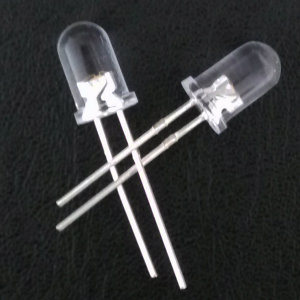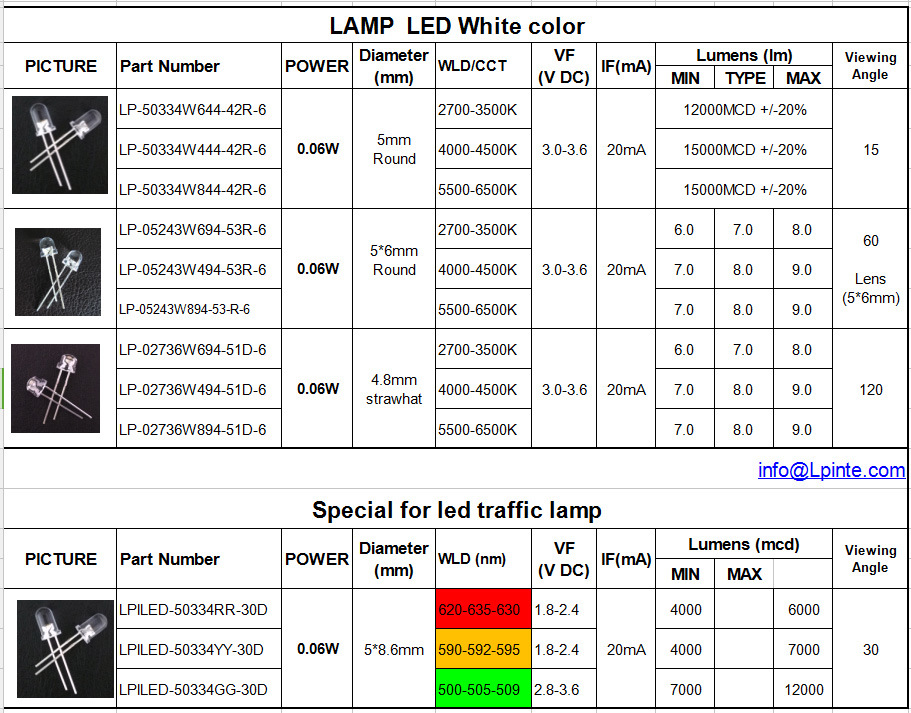Model NO.: LP-50334W
Certification: IMQ, KEMA, LVD, EMC, GOST, PSE, NOM, C-tick, SAA, FCC, Energy Star, CSA, GS, CCC, UL, RoHS, CE
Trademark: LP. LPILED. LPINTE
Transport Package: 75000PCS/CTN, 17.5kgs
Specification: 5mm
Origin: China
Model NO.: LP-50334W
Certification: IMQ, KEMA, LVD, EMC, GOST, PSE, NOM, C-tick, SAA, FCC, Energy Star, CSA, GS, CCC, UL, RoHS, CE
Trademark: LP. LPILED. LPINTE
Transport Package: 75000PCS/CTN, 17.5kgs
Specification: 5mm
Origin: China
5mm round lamp LEDSuper brightness
Long lifespan more than 50, 000 hours
Voltage: 3.0-3.6VDC
LENS: Dia 5mm x L8.6mm
Lead length: 15.4mm
| Part Number                   | POWER | Diameter (mm) | Color | WLD/CCT       | VF(V DC) | IF(mA) | Lumens (lm)              | Viewing Angle | ||
| MIN | TYPE | MAX | ||||||||
| LP-50334W644-42R-6 | 0.06W | 5mm Round | Warm white | 2700-3500K | 3.0-3.6 | 20mA | 13000MCD +/-20% | 15 | ||
| LP-50334W444-42R-6 | Neutral White | 4000-4500K | 15000MCD +/-20% | |||||||
| LP-50334W844-42R-6 | Cool White | 5500-6500K | 15000MCD +/-20% | |||||||
| LP-50334W694-51R-6 | 0.06W | 5mm Round | Warm white | 2700-3500K | 3.0-3.6 | 20mA | 14000MCD +/-20% | 15 | ||
| LP-50334W494-51R-6 | Neutral White | 4000-4500K | 16000MCD +/-20% | |||||||
| LP-50334W894-51R-6 | Cool White | 5500-6500K | 16000MCD +/-20% | |||||||


LPILED,A light-emitting diode (LED) is a two-lead semiconductor light source. It is a p-n junction diode, which emits light when activated. When a suitable voltage is applied to the leads, electrons are able toÂ
Â
recombine with electron holes within the device, releasing energy in the form of photons. This effect is called electroluminescence, and the color of the light (corresponding to the energy of the photon) is determinedÂ
Â
by the energy band gap of the semiconductor.
Â
An LED is often small in area (less than 1 mm2) and integrated optical components may be used to shape its radiation pattern.
Appearing as practical electronic components in 1962, the earliest LEDs emitted low-intensity infrared light. Infrared LEDs are still frequently used as transmitting elements in remote-control circuits, such as those inÂ
Â
remote controls for a wide variety of consumer electronics. The first visible-light LEDs were also of low intensity, and limited to red. Modern LEDs are available across the visible, ultraviolet, and infrared wavelengths,Â
Â
with very high brightness.
Â
Early LEDs were often used as indicator lamps for electronic devices, replacing small incandescent bulbs. They were soon packaged into numeric readouts in the form of seven-segment displays, and were commonlyÂ
Â
seen in digital clocks. LPILED
Â
Recent developments in LEDs permit them to be used in environmental and task lighting. LEDs have many advantages over incandescent light sources including lower energy consumption, longer lifetime, improvedÂ
Â
physical robustness, smaller size, and faster switching. Light-emitting diodes are now used in applications as diverse as aviation lighting, automotive headlamps, advertising, general lighting, traffic signals, cameraÂ
Â
flashes and lighted wallpaper. As of 2015, LEDs powerful enough for room lighting remain somewhat more expensive, and require more precise current and heat management, than compact fluorescent lamp sourcesÂ
Â
of comparable output.
Â
LEDs have allowed new text, video displays, and sensors to be developed, while their high switching rates are also used in advanced communications technology.
 5mm round lamp LED
Super brightness
Long lifespan more than 50, 000 hours
Voltage: 3.0-3.6VDC
LENS: Dia 5mm x L8.6mm
Lead length: 15.4mm
| Part Number                   | POWER | Diameter (mm) | Color | WLD/CCT       | VF(V DC) | IF(mA) | Lumens (lm)              | Viewing Angle | ||
| MIN | TYPE | MAX | ||||||||
| LP-50334W644-42R-6 | 0.06W | 5mm Round | Warm white | 2700-3500K | 3.0-3.6 | 20mA | 13000MCD +/-20% | 15 | ||
| LP-50334W444-42R-6 | Neutral White | 4000-4500K | 15000MCD +/-20% | |||||||
| LP-50334W844-42R-6 | Cool White | 5500-6500K | 15000MCD +/-20% | |||||||
| LP-50334W694-51R-6 | 0.06W | 5mm Round | Warm white | 2700-3500K | 3.0-3.6 | 20mA | 14000MCD +/-20% | 15 | ||
| LP-50334W494-51R-6 | Neutral White | 4000-4500K | 16000MCD +/-20% | |||||||
| LP-50334W894-51R-6 | Cool White | 5500-6500K | 16000MCD +/-20% | |||||||


LPILED,A light-emitting diode (LED) is a two-lead semiconductor light source. It is a p-n junction diode, which emits light when activated. When a suitable voltage is applied to the leads, electrons are able toÂ
Â
recombine with electron holes within the device, releasing energy in the form of photons. This effect is called electroluminescence, and the color of the light (corresponding to the energy of the photon) is determinedÂ
Â
by the energy band gap of the semiconductor.
Â
An LED is often small in area (less than 1 mm2) and integrated optical components may be used to shape its radiation pattern.
Appearing as practical electronic components in 1962, the earliest LEDs emitted low-intensity infrared light. Infrared LEDs are still frequently used as transmitting elements in remote-control circuits, such as those inÂ
Â
remote controls for a wide variety of consumer electronics. The first visible-light LEDs were also of low intensity, and limited to red. Modern LEDs are available across the visible, ultraviolet, and infrared wavelengths,Â
Â
with very high brightness.
Â
Early LEDs were often used as indicator lamps for electronic devices, replacing small incandescent bulbs. They were soon packaged into numeric readouts in the form of seven-segment displays, and were commonlyÂ
Â
seen in digital clocks. LPILED
Â
Recent developments in LEDs permit them to be used in environmental and task lighting. LEDs have many advantages over incandescent light sources including lower energy consumption, longer lifetime, improvedÂ
Â
physical robustness, smaller size, and faster switching. Light-emitting diodes are now used in applications as diverse as aviation lighting, automotive headlamps, advertising, general lighting, traffic signals, cameraÂ
Â
flashes and lighted wallpaper. As of 2015, LEDs powerful enough for room lighting remain somewhat more expensive, and require more precise current and heat management, than compact fluorescent lamp sourcesÂ
Â
of comparable output.
Â
LEDs have allowed new text, video displays, and sensors to be developed, while their high switching rates are also used in advanced communications technology.
Â
Absolute rotary Encoder measure actual position by generating unique digital codes or bits (instead of pulses) that represent the encoder`s actual position. Single turn absolute encoders output codes that are repeated every full revolution and do not output data to indicate how many revolutions have been made. Multi-turn absolute encoders output a unique code for each shaft position through every rotation, up to 4096 revolutions. Unlike incremental encoders, absolute encoders will retain correct position even if power fails without homing at startup.
Absolute Encoder,Through Hollow Encoder,Absolute Encoder 13 Bit,14 Bit Optical Rotary Encoder
Jilin Lander Intelligent Technology Co., Ltd , https://www.landerintelligent.com